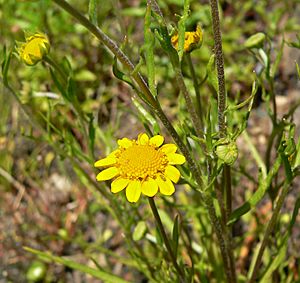Burke's goldfields facts for kids
Quick facts for kids Lasthenia burkei |
|
|---|---|
 |
|
| Conservation status | |
| Scientific classification | |
| Kingdom: | |
| (unranked): | |
| (unranked): | |
| (unranked): | |
| Order: | |
| Family: | |
| Tribe: | |
| Genus: |
Lasthenia
|
| Species: |
L. burkei
|
| Binomial name | |
| Lasthenia burkei Greene
|
|
Lasthenia burkei is a special and rare flowering plant. It is also known as Burke's goldfields or Burke's baeria. This plant belongs to the daisy family, just like sunflowers and dandelions!
Contents
Where Does It Live?
This unique plant only grows in California, which means it is endemic to this state. You can find it in three counties north of the San Francisco Bay Area. These counties are Lake, Mendocino, and Sonoma.
What Kind of Home Does It Like?
Lasthenia burkei loves to grow in wet places. It thrives in moist spring meadows and special areas called vernal pools. Vernal pools are seasonal wetlands that fill with water in the spring and then dry up later in the year.
Why Is It So Rare?
This plant is considered an endangered species. This means it is at a very high risk of disappearing forever. Both the United States federal government and the state of California have listed it as endangered.
How Many Are Left?
Experts believe there are fewer than ten groups of these plants left in the world. They are all found in the three California counties mentioned earlier.
What Threatens It?
The biggest danger to Lasthenia burkei is the loss of its home. Its rare wetland habitats are being destroyed or damaged. This makes it very hard for the plant to survive and grow. Because of these threats, scientists are worried that this plant could become extinct very soon if we don't protect its habitat.
What Does It Look Like?
Lasthenia burkei is an annual herb. This means it is a plant that completes its entire life cycle, from seed to flower to seed, in just one year.
Its Stems and Leaves
The plant grows upright and has hairy stems. Its leaves are a few centimeters long and can be thin, straight, or deeply divided into narrow, pointed parts.
Its Flowers
At the top of each stem is a flower head. This is a cluster of many small flowers that look like one big flower. The base of the flower head has hairy leaf-like structures called phyllaries.
The center of the head is filled with many small, yellow disc florets. Around the edge, there are a few short ray florets, which are usually yellow too. These are the "petals" you see.
Its Fruit
After the flowers bloom, the plant produces a small, hairy, club-shaped fruit. This fruit is called an achene and is less than 2 millimeters long. It contains the plant's seeds.


